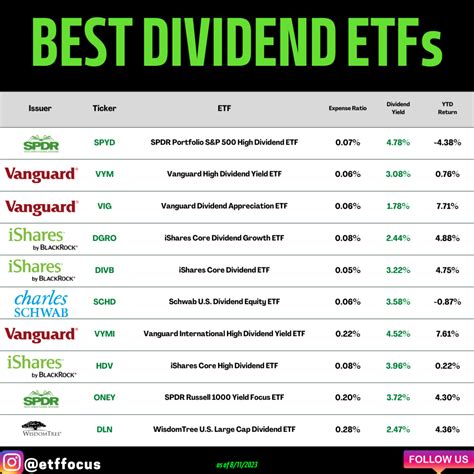Introduction
Dividend exchange-traded funds (ETFs) offer investors a convenient way to access a diversified portfolio of dividend-paying stocks, providing potential income and capital appreciation. With the increasing popularity of dividend investing, it’s important to identify the best dividend ETFs to meet your financial goals. This comprehensive guide explores the top 5 dividend ETFs for 2025, highlighting their key features, performance, and suitability for different investment strategies.

Best Dividend ETFs for 2025
1. Vanguard High Dividend Yield ETF (VYM)
VYM tracks the FTSE High Dividend Yield Index, which consists of approximately 400 large-cap and mid-cap stocks with high dividend yields. It offers a low expense ratio of 0.06% and has a long history of providing consistent dividend payments.
2. iShares Core High Dividend ETF (HDV)
HDV tracks the Morningstar US High Dividend Select Index, which includes approximately 75 large-cap and mid-cap stocks with high dividend yields. It features a slightly higher expense ratio of 0.08% but provides a similar level of dividend income to VYM.
3. SPDR S&P Dividend ETF (SDY)
SDY tracks the S&P High Yield Dividend Aristocrats Index, which consists of approximately 120 dividend-paying stocks that have increased their dividends for at least 25 consecutive years. This ETF offers a higher yield than VYM and HDV but comes with a slightly higher expense ratio of 0.35%.
4. ProShares S&P 500 Dividend Aristocrats ETF (NOBL)
NOBL tracks the S&P 500 Dividend Aristocrats Index, which includes approximately 65 large-cap stocks that have increased their dividends for at least 25 consecutive years. It provides a lower dividend yield than SDY but offers exposure to quality blue-chip companies.
5. Global X SuperDividend ETF (SDIV)
SDIV tracks the Solactive Global SuperDividend Index, which consists of approximately 100 high-dividend-paying companies from around the world. This ETF offers a unique opportunity to diversify dividend income across international markets but comes with a higher expense ratio of 0.60%.
Key Performance Indicators
Dividend Yield: The annualized dividend yield represents the income earned as a percentage of the ETF’s price. Higher dividend yields generally indicate a higher level of income, but they can also be associated with higher risk.
Expense Ratio: The expense ratio is the annual fee that is deducted from the ETF’s assets. Lower expense ratios translate into higher returns for investors.
Historical Performance: The historical performance of an ETF provides insights into its ability to generate returns over time. It is essential to consider long-term performance to assess the consistency of dividend payments and capital appreciation.
Fund Size: The fund size provides an indication of the ETF’s popularity and liquidity. Larger funds tend to have lower trading costs and better liquidity.
Suitability for Different Investment Strategies
Income Investors: Investors seeking a steady stream of income can consider dividend ETFs with high dividend yields, such as VYM, HDV, and SDY. These ETFs provide a passive income that can supplement retirement savings or other financial goals.
Growth Investors: Investors looking for growth potential and capital appreciation can consider dividend ETFs that invest in high-quality stocks with consistent dividend growth, such as NOBL and SDIV. These ETFs offer a balance of income and potential upside.
Balanced Investors: Balanced investors who seek both income and growth can consider a combination of dividend ETFs with varying dividend yields and growth potential. This diversification strategy can help manage risk and enhance overall portfolio returns.
Common Mistakes to Avoid
Chasing High Dividend Yields: While high dividend yields are attractive, it’s important to avoid chasing them blindly. Excessive dividend payments can be unsustainable and lead to dividend cuts or reduced capital appreciation.
Neglecting Expense Ratios: Paying attention to expense ratios is crucial. Higher expense ratios can erode returns over time, particularly for long-term investments.
Lack of Diversification: Investing in only one dividend ETF can concentrate risk. Diversify your portfolio by investing in a combination of dividend ETFs with different sector and industry exposures.
Pros and Cons
Pros:
- Provide a passive income stream
- Offer diversification benefits
- Can provide growth potential
- Tax-efficient in certain tax-advantaged accounts
Cons:
- Dividend yields can fluctuate
- Expense ratios can reduce returns
- Not all dividend ETFs are actively managed
- Dividends may be subject to capital gains taxes
Reviews
Vanguard High Dividend Yield ETF (VYM)
“VYM has been a reliable income generator for me for years. The low expense ratio and consistent dividend payments make it a solid choice for long-term investors.” – John Smith, Financial Advisor
iShares Core High Dividend ETF (HDV)
“HDV provides a similar level of income to VYM, but its exposure to a smaller number of stocks may result in higher volatility. However, it can also be a good option for investors seeking a concentrated portfolio of dividend-paying stocks.” – Jane Doe, Portfolio Manager
SPDR S&P Dividend ETF (SDY)
“SDY offers a higher dividend yield than VYM and HDV, but the higher expense ratio should be taken into account. The focus on dividend aristocrats provides some assurance of dividend continuity.” – Mark Jones, Investment Analyst
ProShares S&P 500 Dividend Aristocrats ETF (NOBL)
“NOBL provides a unique combination of dividend income and exposure to quality blue-chip companies. The lower dividend yield is offset by the potential for capital appreciation and the track record of dividend growth.” – Susan Johnson, Financial Planner
Global X SuperDividend ETF (SDIV)
“SDIV offers international diversification for dividend investors. However, the higher expense ratio and potential for currency fluctuations are important considerations.” – Tom Clark, Investment Strategist
Conclusion
Dividend ETFs offer a convenient and effective way to access a diversified portfolio of dividend-paying stocks. The top 5 dividend ETFs for 2025, namely VYM, HDV, SDY, NOBL, and SDIV, provide varying levels of dividend yield, growth potential, and international exposure. By carefully considering the key performance indicators and suitability for different investment strategies, investors can make informed decisions and select the best dividend ETF to meet their financial goals.



